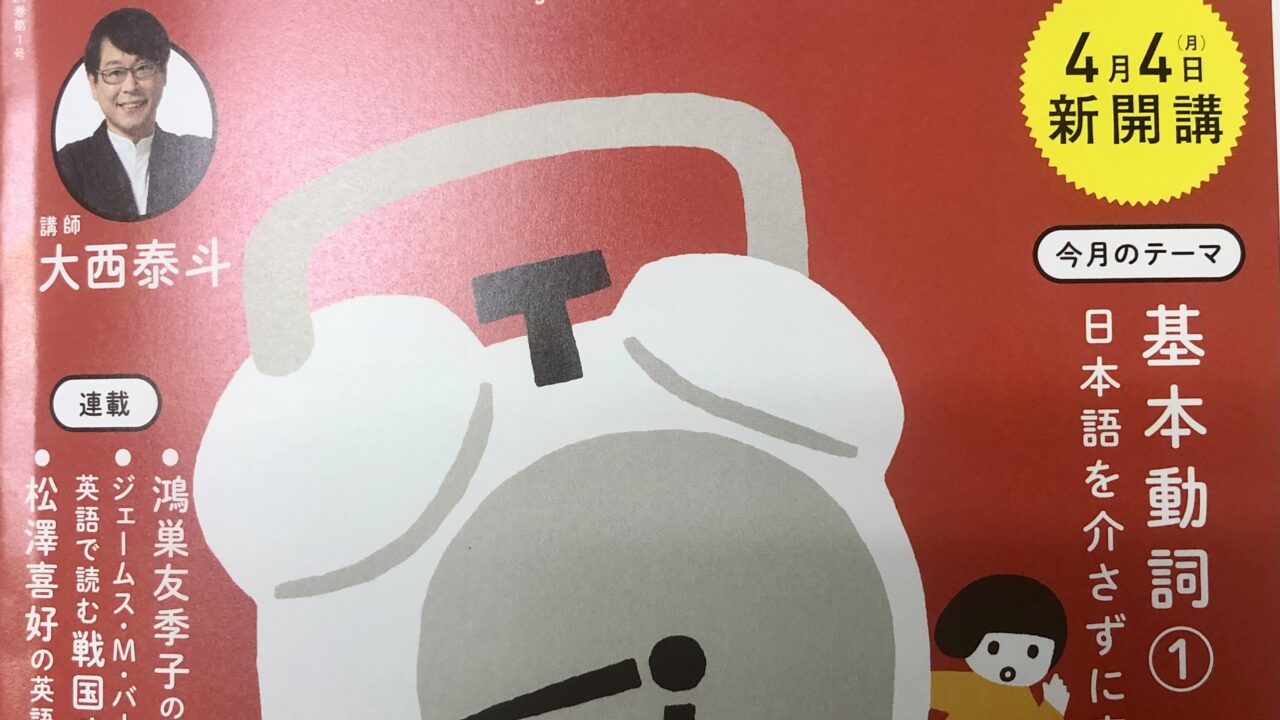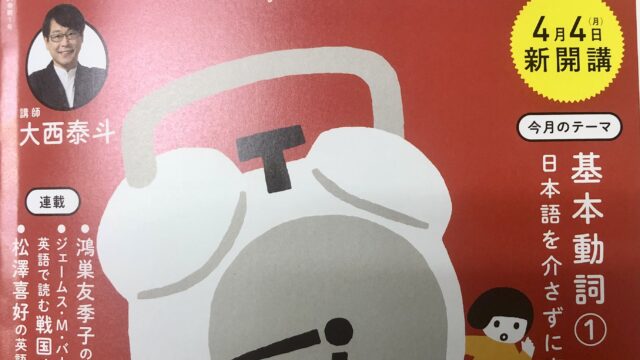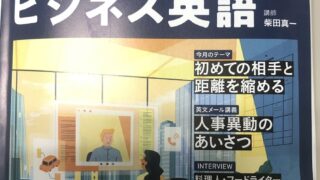【ラジオ英会話】Lesson 7: have の基本イメージ – April 12 Tuesday, 2022

April 12 Tuesday, 2022
Lesson 7: have の基本イメージ
☆Opening
O: Hey, Chris. I have some good news for you.
C: Oh, great! What’s that?
O: I’ve lost some weight.
C: Ah…why is that good news for me?
O: Ah, you have to carry me when I’m drunk, right? So that’s why the good news.
C: Oh, no! He looked that way, yeah.
~~~~
C: Look I’m still recovering from Onishi Sensei’s opening. So let’s carry on.
☆Words & Phrases
**good news and bad news:
I have good news and bad news for you.
**teenager:
The bad news is that I haven’t found a human teenager friend for you.
**too bad:
Oh, that’s too bad.
**android:
The good news is that I can make an android boy.
Really? What will he look like?
**blond hair:
He will have blond hair and green eyes.
(It/That) Sounds good. What’s his name?
You can decide.
☆Grammar & Vocabulary
① Tell me the bad news first.
授与型
英語は「配置の言葉」。配置の基本は「基本文型」で、この文はそのうちの「授与型(SVOO)」が使われている。
授与型=動詞の後に目的語を2つとり、「〜に…をあげる・くれる」を表す型。give が典型的な動詞だが、どういった動詞を使ってもこの型を使えば授与の意味が生じる。
この文も、「私に・悪い方のニュースを・言って/教えてください」と、授与を表している。
② The good news is that I can make an android boy.
説明型の説明語句の位置
英語は「配置の言葉」で、位置が表現に機能を与える言葉。
この文の that節は、説明型 be動詞文の「説明語句」の位置にある。この位置にあればどういった表現であっても – to不定詞でも、動詞 -ing形でも、過去分詞でも – 主語の説明となる。
この文の that I can make an android boy は The good news の説明となっている。
☆Feel English & Key Sentence
He will have blond hair and green eyes.
have は「持っている」と訳されることが多い動詞だが、基本イメージは「周りにある」。位置を表す動きのない静的な動詞のイメージ。
have の表す位置は周り・内部を含む。この文の blond hair と green eyes もそうした位置関係にあることを示している。
★have の位置関係をつかむ★
① have two windows / have a brother
→ どちらも「周りにある」
② have a lot of rain
→「雨が周りにある」という位置関係
③ have an accident / have a party / have a checkup
→「出来事」が「周り」で起こっていることを表す
④ have a headache / have a doubt
→ 疾病にかかる(a cold: 風邪、a stomachache: 腹痛、など)
→ 疑いや考え (an idea) などを「心に抱いている」
☆Expression in Action
①私はひどい頭痛がします。
**terrible:
②今日ここにあなたをお招きできてうれしく思います。
③幸運なことに、私たちは休日たくさんの日差しに恵まれました、だから私はよく日焼けしているのです。
**a lot of sun:
**tan:
___________________
April 12 Tuesday, 2022
Lesson 7 have の基本イメージ
(日本語訳・解説付き)
☆Opening
O: Hey, Chris. I have some good news for you.
C: Oh, great! What’s that?
O: I’ve lost some weight.
C: Ah…why is that good news for me?
O: Ah, you have to carry me when I’m drunk, right? So that’s why the good news.
C: Oh, no! He looked that way, yeah.
~~~~
C: Look I’m still recovering from Onishi Sensei’s opening. So let’s carry on.
☆Words & Phrases
**good news and bad news: 良い知らせと悪い知らせ
I have good news and bad news for you.
(あなたに良い知らせと悪い知らせがあります)
※ good news and bad news は、日本語ではあまり言わないかもですが英語ではよく言われるフレーズです
**teenager: ティーンエイジャー
The bad news is that I haven’t found a human teenager friend for you.
(悪い知らせは、あなたにティーンエイジャーの人間の友達をまだ見つけられていないことです)
※ haven’t found は現在完了形ですね。過去から今に迫ってくる、が現在完了形のイメージ。スタイン博士はジーニーちゃんのために過去から今までずっとお友達を探していたのでしょう。
※ teenager(ティーンエイジャー)は10代、と思われがちですが “teen” なので、thirteen(13歳) fourteen(14歳)fifteen(15歳)sixteen(16歳)seventeen(17歳)eighteen(18歳)nineteen(19歳) までです。
ten(10歳)eleven(11歳)twelve(12歳)はティーンエイジャーではありません。
**too bad: 残念な
Oh, that’s too bad.
(まあ、それは残念です)
**android: アンドロイド、人造人間
The good news is that I can make an android boy.
(良い知らせは、私はアンドロイドの男の子が作れるということです)
Really? What will he look like?
(本当ですか?彼はどのような見た目になるのですか?)
※ここの will は「未来の状況にふっと目をやっている」感覚や視線の送り方が will に反映されています。will だから常に「〜だろう」とはなりません。日本語は英語とイコールの言葉ではないのです!
**blond hair: 金髪、ブロンド
He will have blond hair and green eyes.
(彼はブロンドの髪と緑の目を持つことになります)
※金髪は yellow hair ではないんですね。そして白髪は white hair ではなく gray hair です!
(It/That) Sounds good. What’s his name?
(いいですね。彼の名前は何ですか?)
※主語の It/That が省略されている「説明型オーバーラッピング」の文です。「It/That = good のように聞こえる(sounds)」
You can decide.
(あなたが決めるといい)
※ 許可の can です。「〜していいよ」という気軽な文。
☆Grammar & Vocabulary
① Tell me the bad news first.
(まず悪い知らせを教えてください)
授与型
英語は「配置の言葉」。配置の基本は「基本文型」で、この文はそのうちの「授与型(SVOO)」が使われている。
授与型=動詞の後に目的語を2つとり、「〜に…をあげる・くれる」を表す型。give が典型的な動詞だが、どういった動詞を使ってもこの型を使えば授与の意味が生じる。
この文も、「私に・悪い方のニュースを・言って/教えてください」と、授与を表している。
② The good news is that I can make an android boy.
(良い知らせは、私はアンドロイドの男の子が作れるということです)
説明型の説明語句の位置
英語は「配置の言葉」で、位置が表現に機能を与える言葉。
この文の that節は、説明型 be動詞文の「説明語句」の位置にある。この位置にあればどういった表現であっても – to不定詞でも、動詞 -ing形でも、過去分詞でも – 主語の説明となる。
この文の that I can make an android boy は The good news の説明となっている。
☆Feel English & Key Sentence
He will have blond hair and green eyes.
(彼はブロンドの髪と緑の目を持つことになります)
have は「持っている」と訳されることが多い動詞だが、基本イメージは「周りにある」。位置を表す動きのない静的な動詞のイメージ。
have の表す位置は周り・内部を含む。この文の blond hair と green eyes もそうした位置関係にあることを示している。
★have の位置関係をつかむ★
① have two windows / have a brother
2つ窓がある/兄弟がいる
→ どちらも「周りにある」
② have a lot of rain
たくさん雨が降る
→「雨が周りにある」という位置関係
③ have an accident / have a party / have a checkup
事故に遭う/パーティーをする/健康診断を受ける
→「出来事」が「周り」で起こっていることを表す
④ have a headache / have a doubt
頭痛がする/疑っている
→ 疾病にかかる(a cold: 風邪、a stomachache: 腹痛、など)
→ 疑いや考え (an idea) などを「心に抱いている」
☆Practice
OK. Let’s practice the new verb “have,” this we use so often, right?
Now, unlike “make” which implies a lot of action, “have” is a static verb.
**static: 静的な、静止の
So we’re gonna focus on “position.”
For example, I have two brothers.
Two brothers are next to me, close to me, all around me.
It’s all about “position” with us, OK?
Let’s practice together.
have two windows
have a brother
So here we are.
The two windows, the brother are next to us, around us.
That’s all. There that in mind, that’s the practice today.
Let’s practice together.
have two windows
have a brother
So here we are.
The two windows, the brother are next to us, around us.
That’s all.
There that in mind, that’s the practice today.
Last chance!
have two windows – Try!
have a brother
Excellent.
☆Expression in Action
①私はひどい頭痛がします。
I have a terrible headache.
**terrible: ひどい
②今日ここにあなたをお招きできてうれしく思います。
It’s good to have you here today.
③幸運なことに、私たちは休日たくさんの日差しに恵まれました、だから私はよく日焼けしているのです。
Luckily, we had a lot of sun on our holiday, so I have a nice tan.
**luckily: 幸運なことに、運よく
**a lot of sun: たくさんの日差し
**tan: 日焼け
※自分が言えそうなフレーズは全部頭に入れておく、が鉄則!!
___________________
April 12 Tuesday, 2022
Lesson 7 have の基本イメージ
(日本語→英語バージョン)
☆Words & Phrases
**良い知らせと悪い知らせ:
あなたに良い知らせと悪い知らせがあります。
→
**ティーンエイジャー:
悪い知らせは、あなたにティーンエイジャーの人間の友達をまだ見つけられていないことです。
→
※現在完了形の文ですね。過去から今に迫ってくる、イメージ。スタイン博士はジーニーちゃんのためにずっとお友達を探していたのでしょう。
**残念な:
まあ、それは残念です。
→
**アンドロイド、人造人間:
良い知らせは、私はアンドロイドの男の子が作れるということです。
→
本当ですか?彼はどのような見た目になるのですか?
→
※ここの will は「未来の状況にふっと目をやっている」感覚や視線の送り方が will に反映されています。will だから常に「〜だろう」とはなりません。日本語は英語とイコールの言葉ではないのです!
**金髪、ブロンド:
彼はブロンドの髪と緑の目を持つことになります。
→
※金髪は yellow hair ではないんですね。そして白髪は white hair ではなく gray hair です!
いいですね。彼の名前は何ですか?
→
※主語の It/That が省略されている「説明型オーバーラッピング」の文です。
あなたが決めるといい。
→
※ 許可の can です。「〜していいよ」という気軽な文


